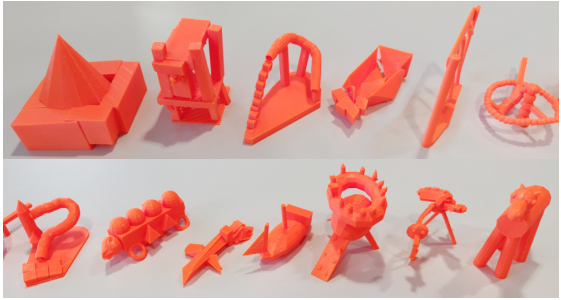In a thesis entitled “Designing Playground Equipment with VR and 3D Printing,” author Christian Knaapen argues that virtual reality is necessary in designing objects in 3D. In CAD programs, he says, there is a disconnect between the 3D object on its 2D screen and the final object, which can be walked around and interacted with – hence the necessity for virtual reality. However, converting models made in virtual reality to 3D prints is not straightforward, as the 3D prints need to show a number of desired properties. These properties include:
- The object should consist of one connected component that touches the printing platform
- It should be able to stand without falling over
- It should be structurally sound
For his project, Knaapen implements a program that analyzes these properties on models made in virtual reality. It is the first 3D print analysis program, he says, that works in virtual reality.
To test the program, Knaapen asked 35 children at a local school to design playground equipment in Google Blocks, after which the models were analyzed and 3D printed. The children worked in groups of two or three, forming 16 groups in total. The project consisted of three sessions: in the first, the children were introduced to Google Blocks and began designing their playground equipment. They finished their designs in the second session, and in the third session they used Knaapen’s software program to analyze their own models. The designs were then 3D printed and tested for the desired properties, and a winning design was chosen.
The prints were tested on connectedness, balance and strength. Connectedness was tested by seeing if the print remained in one part after the supports were removed, and balance was tested by placing the print on a flat surface in the orientation in which it was designed, and seeing if it remained upright. Strength was tested by performing drop tests from a height of 75 centimeters (the height of a standard table) onto a hard surface. If the print did not break or visibly deform, it was considered strong enough for everyday use.
13 models were connected and did not fall apart after the supports were removed. 14 passed the balance test, and seven survived the strength test.
“We can compare these results to the predictions of the analyses of our program,” says Knaapen. “We do this separately for each property, as seen in table 5.3. The connectedness analysis correctly predicted the outcome in 92.9% of cases, where the one time that it did not predict correctly was due to print accuracy and thin areas. We observe that the balance analysis correctly predicted everything. Still, we can not conclude it is perfect considering the sample size. We only got to test our program on 16 models which means there could be edge cases where that functionality is not sufficient. The strength analysis shows some issues and only predicted the strength of the physical print correctly in 50% of cases. Furthermore in cases where it did predict issues with strength, it often did not predict what part of the model would be weak correctly, as can be seen in figure 5.10.”
While further research is needed, Knaapen concludes, the project was a good first step in gaining understanding of what it takes to convert models created in virtual reality to 3D prints. Although not the purpose of the experiment, it was also a great way to introduce children to 3D printing and virtual reality by allowing them to design their own playground equipment.
Discuss this and other 3D printing topics at 3DPrintBoard.com or share your thoughts below.




15 Replies to “Children Design Playground Equipment to Test 3D Printing and Virtual Reality Software”
Comments are closed.